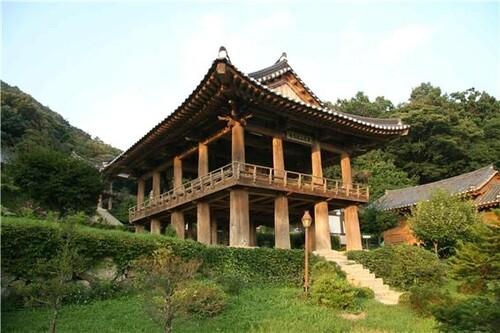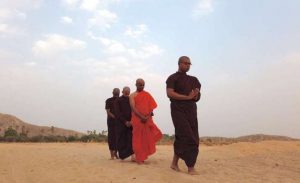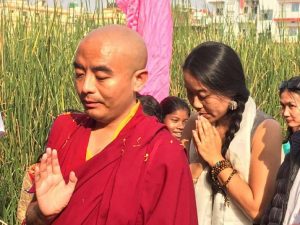
Two ancient pavilions at the seventh century Korean Buddhist mountain temple Buseok-sa (부석사) will be officially designated as National Treasures, South Korea’s Cultural Heritage Administration has announced.
In its announcement on 27 August, the Cultural Heritage Administration identified Anyang-ru Pavilion and Beomjon-gak Pavilion at Buseok-sa in Korea’s North Gyeongsang Province.
Anyang-ru Pavilion was built on the upper floor of a gate tower in 1576, after the original single-story structure of Gangun-gak was lost to a fire 1555. Beomjon-gak Pavilion, which is notable for its distinctive roof structure, dates to the 18th century. According to historical records, Beomjon-gak used to house an iron bell, which disappeared during the 19th century. The Cultural Heritage Administration added that Beomjon-gak is considered to be a structure of great heritage value because of the unusually complex and aesthetically pleasing design and construction of the roof.
Designated National Treasures are tangible heritage artifacts or sites that have been recognized by the Cultural Heritage Administration for their exceptional artistic, cultural, and historical value, following deliberation by the Cultural Heritage Committee.
Buseok-sa, also known as “The Temple of the Floating Stone,” was founded by the eminent scholar-monk Uisang (625–702 CE) in 676, during the Unified Silla period, after he returned from studying in Tang dynasty China. According to historical records, after construction was completed, Uisang held Dharma assemblies at the temple for 40 days, giving teachings on the Flower Garland Sutra (화엄경).
A UNESCO World Heritage Site situated on the slopes of Mount Bonghwang, Buseok-sa is administered by the Jogye Order of Korean Buddhism. The temple is home to five National Treasures. Notable among them is the Dharma hall Muryangsujeon, which houses a statue of Amitabha Buddha. Muryangsujeon is the second-oldest standing wooden building in South Korea, re-constructed in 1376 and considered a prime example of traditional Korean architecture. The 25 buildings, pagodas, and other structures that make up the temple complex were laid out to form a Bodhi-mandala and is considered an ideal location for spiritual cultivation.
In June 2018, Buseok-sa was one of seven ancient Buddhist mountain temples, dated to the seventh to ninth centuries, to be listed as UNESCO World Heritage Sites by unanimous decision at the annual World Heritage Committee meeting.*
The seven Buddhist monasteries—Beopju-sa (법주사) in Boeun, North Chungcheong Province; Bongjeong-sa (봉정사) in Andong, North Gyeongsang; Buseok-sa (부석사) in Yeongju, North Gyeongsang; Daeheung-sa (대흥사0) in Haenam, South Jeolla; Magok-sa (마곡사) in Gongju, South Chungcheong; Seonam-sa (선암사) in Suncheon, South Jeolla; and Tongdo-sa (통도사) in South Gyeongsang—were all founded during the Three Kingdoms period (57 BCE–668 CE), which comprised Baekje, Silla, and Goguryeo, later to become known as Goryeo, or the Unified Silla (668–935).
“Buddhism has a long history that has traversed a number of historical eras in the Korean Peninsula,” The World Heritage Committee said in its decision at the time. “The seven mountain monasteries . . . offer a distinctively Korean instantiation of Buddhist monastic culture from the seventh century to the present day. These mountain monasteries are sacred places and provide an exceptional testimony to their long and continuing traditions of Buddhist spiritual practice.” (UNESCO)
According to census data for 2015, the majority of South Korea’s population—56.1 per cent—holds no religious affiliation. Christians make up the largest religious segment of the population at 27.6 per cent, while Buddhists account for 15.5 per cent.
* Seven Buddhist Mountain Temples in South Korea Receive UNESCO World Heritage Status (BDG)
See more
부석사
Anyangru and Beomjong-gak, beauty of UNESCO World Heritage Buseoksa Temple, designated as Treasures (K-odyssey)
Anyang-ru and Beomjongak to become treasures of Korea (The Dong-a Ilbo)
Pavilions at UNESCO-desginated Buddhist Mountain Monastery to be Named Nat’l Treasures (KBS World)
Amended Draft Decision – UNESCO World Heritage Centre (UNESCO; PDF file)
Related news reports from BDG
New Korean Buddhist Temple to Open in Bodh Gaya, India
Korea Resumes Annual Lantern Festival to Celebrate the Birth of the Buddha
Association of Korean Buddhist Orders Publishes Buddhist National Treasures of Korea
Korean Buddhist Manuscripts Exhibited for Hangul Day
Buddhist Temple to Open Tripitaka Koreana to the Public for the First Time














